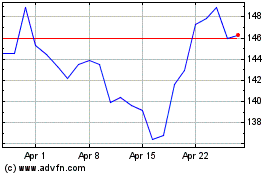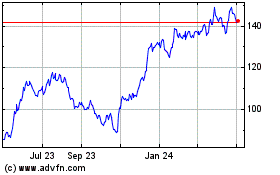Why the Credit-Card Boom May Have Just Peaked
May 16 2018 - 5:59AM
Dow Jones News
By AnnaMaria Andriotis
Following some of their strongest years ever, credit-card
issuers are grappling with an uneasy future.
Rising loan losses and increased rewards expenses are putting
pressure on card lenders' returns. The result is that one of the
most profitable consumer-lending categories in recent years may
become more of a middling player.
"The easy money has been made in card lending," said Don
Fandetti, consumer finance analyst at Wells Fargo & Co.
While cards remain highly lucrative for banks, the benefits of a
rising interest-rate environment have been muted lately. The added
revenue of cardholders paying more in interest payments each month
has also been offset by growing competition from lenders trying to
poach card customers by offering lower rates.
Credit cards became an appealing loan category for banks in the
wake of the last recession. Card balances grew at an accelerating
pace in recent years, reaching a 7% year-over-year growth rate
early last year. Total balances exceeded $1.03 trillion in January,
the highest on record, according to the Federal Reserve.
But that coincided with an increase in loan losses from
historically low levels, as banks set aside more money for future
write-offs. They also tightened their underwriting standards,
resulting in slowing growth. Card-balance growth in March was up
4.8% from a year earlier, compared with a 6.1% increase in March
2017 from the year-earlier period.
Five of the largest credit-card issuers -- American Express Co.,
Capital One Financial Corp., Citigroup Inc., Discover Financial
Services and Synchrony Financial -- generated a median return of
2.1% on their assets for common shareholders in the first quarter,
up from 2% a year earlier but down from 2.6% two years prior,
according to analysis by Autonomous Research. The recent peak was
3.7% in the second quarter of 2011, according to an industry
analysis by Autonomous at the time.
"The industry was at an unsustainable high...so coming down is
expected, " David Nelms, Discover's chief executive, said in an
interview.
The pickup in returns for most banks in the first quarter was
primarily the result of tighter underwriting, which helped slow the
rate of loan loss increases and the amount of money banks are
setting aside for future losses. U.S. tax-law changes that lowered
corporate tax rates also helped.
Still, returns remain largely unchanged -- and in some cases
down -- from about 2 1/2 years ago when the Fed began raising
rates. "Rising rates [are] a mixed blessing for the card issuers at
this point," said Brian Foran, analyst at Autonomous Research.
Companies aren't getting the full benefit of the higher rates
because while interest charges on cards are rising, so are the
interest rates card issuers are having to pay bank customers for
their online deposit accounts.
Some analysts predict that profitability will keep falling,
though it remains significantly higher than many other banking
products. Credit cards delivered a projected 3.8% return on assets
to 14 large banks highly concentrated in the card business last
year, compared with an overall 1.35% projected return for all
commercial banks, according to payments consulting firm Mercator
Advisory Group Inc. Mercator projects that card returns will fall
in 2018 to 3.5% due to losses and challenges cutting further
costs.
Stocks of card companies have reflected the concern, with
Discover shares down 0.8% so far this year, and Synchrony
Financial, the largest U.S. store credit-card issuer, down 11.4%,
compared with a 4% gain in the KBW Nasdaq Bank index.
Credit-card losses have been mostly rising over the past two
years after hovering around near-record lows. The average net
charge-off rate -- the share of outstanding debt that issuers wrote
off as a loss -- for eight of the largest credit-card issuers
reached a nearly five-year high of 3.46% in the first quarter,
according to Fitch Ratings. The increases have become worrisome
indicators for some shareholders of consumers' inability to pay
debts at a time when unemployment is low.
Another pain point for card issuers is the cost they incur from
so-called gamers, who search for the highest rewards on their
cards. These consumers sign up for credit cards with rich sign-up
bonus offerings and then stop using the card once they have tapped
out the early rewards.
U.S. credit-card attrition rates, a measure of how many cards
consumers and card issuers close, reached 15% in 2017, up from less
than 10% a year earlier, according to Mercator.
Meanwhile, banks and fintech lenders that originate personal
loans have been increasing solicitations in recent quarters. Many
of these offers are targeting consumers with credit-card debt and
pitching the opportunity to roll over that debt into a personal
loan at a lower interest rate. Their prime targets are the
customers who card issuers want to keep most: those with high
credit scores who carry a card balance each month.
A record 516 million personal loan solicitations were mailed out
in the first quarter, up 46% from a year ago, according to
estimates from market research firm Competiscan. This marked the
fifth-consecutive record-breaking quarter.
(END) Dow Jones Newswires
May 16, 2018 05:44 ET (09:44 GMT)
Copyright (c) 2018 Dow Jones & Company, Inc.
Capital One Financial (NYSE:COF)
Historical Stock Chart
From Mar 2024 to Apr 2024

Capital One Financial (NYSE:COF)
Historical Stock Chart
From Apr 2023 to Apr 2024
